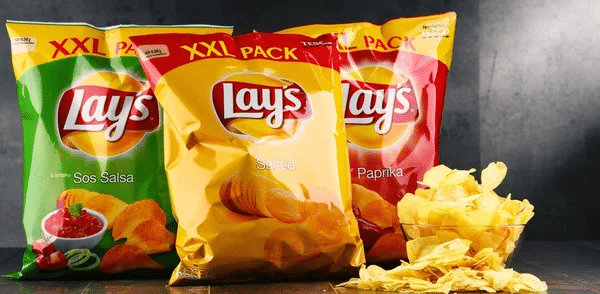
“Bet You Can Eat Just One, But Maybe You Shouldn’t”
First it was our gas-powered cars. Then it was our gas stoves, then water heaters, dish washers, etc., etc., etc. Now, they’re invading our pantries and going after … our chips!
Gasp, what? Our chips? That’s a snack too far, who is responsible for this?
Exactly …. WHO, … The World Health Organization (WHO) is now dictating food ingredients, and marching to the beat of their intrusive drum is PepsiCo, one of the largest snack and beverage manufacturers in the world.
By 2030 the company has “two new ambitious nutrition goals” that they want to reach. First, the firm wants to reduce the amount of sodium in at least 75 percent of its products worldwide. PepsiCo also announced that it would seek to promote nutritionally diverse diets. They believe they can accomplish this by promoting the use of “diverse ingredients” such as legumes, plant-based proteins, fruits, vegetables, nuts, and seeds in its food offerings.
I’m wondering if diverse ingredients will include low sodium grasshoppers and June bugs at some point. PepsiCo Executive Vice President and Chief Science Officer Rene Lammers explained it this way:
“We are in a constant cycle of innovation to reimagine the foods we make and how we make them, so we can bring better choices to our consumers, without ever compromising on taste. Consumers enjoy our products more than one billion times a day, which provides an opportunity and the privilege to have an impact. We set a high bar to improve the nutritional profile of our products, and these new goals reaffirm our ambitions.”
I think PepsiCo is confusing ambition with woke obedience. Stage one, fall in line with the powers that be and initiate the changes they want. Stage two, use smoke and mirrors with your consumers. Convince them that the changes are for their benefit, even though you know that the real goal is something totally different.
According to WHO statistics, which are always so trustworthy (Cough, Cough), adults worldwide consume 4,310 mg of sodium, which is over twice the organization’s recommended limit of 2,000 mg per day.
In the U.S., according to another trustworthy organization, the Centers for Disease Control and Prevention (CDC), average Americans consume 3,400 mg per day of sodium which is more than 1,000 mg over the federal recommendation of 2,300 mg.
Mother WHO wanted to remind everyone that high sodium consumption can raise blood pressure and increases the risk of heart diseases, gastric cancer, obesity, osteoporosis, Meniere’s disease, and kidney disease.
The CDC added that Savory snacks, including chips, pizzas, sandwiches, cheese, breads, and rolls are among the top ten sources of sodium in the U.S.
According to the announcement, Lammers stated:
“An industry wide approach is necessary to meaningfully reduce sodium intake and introduce important sources of nutrition to help diversify diets. And it’s important for us to take a leadership position to help be a catalyst for change.”
The news announcement went on to say that:
“PepsiCo is setting a new sodium reduction goal, with category targets that consider guidance from public health experts including the World Health Organization and are approximately 15-30 percent lower than the company’s current target for key convenient food categories. Our new sodium goal aims for a 15 percent sodium reduction in our U.S. Lay’s Classic Potato Chips, which would result in a sodium level of 140 mg per 28 g serving.”
The company said that its research and development people are working to find ways to “optimize flavor while using less sodium.” Which begs the question, what are you going to put in our chips to “enhance” flavor to replace the sodium? Is this mystery ingredient in reality going to be more harmful than the sodium, and you just forgot to mention that?”
No announcement from a food conglomerate concerning changes that will affect the taste of their product is complete without a so called “expert” there to reassure the public that the changes will be negligible. In this case it’s Allrecipes columnist, Novella Lui.
“If you just so happen to be a supertaster, you may notice a slight difference in the chip flavor, but chances are you won’t be able to detect any change in Lay’s Potato Chips’ appearance or taste. So, don’t panic, there’s no reason to stock up on potato chips because you will likely end up with something that tastes like the same Lay’s you know and love, only a little better for you.”
No, you won’t have to be a super taster. If you are a fan of Lays Potato Chips, you can rest assured that they are going to taste different. The larger question is why is WHO suddenly so interested in “sodium” content. The same people that hid the source of covid, compounded the realities of it every step of the way with lies and unnecessary lockdowns, and support the radical reduction of the world’s population have now turned their attention to snack foods. Why?
Could the reason be that so many eat them nonchalantly and that by tampering with them it grants them access to a broad scope of the population through simple unassuming snack consumption?
If this sounds even remotely like a conspiracy theory, you must have been very busy and distracted for at least the last decade. So, know this, WHO and the CDC are powerful entities that are being driven by something even more powerful.
It’s time for the American people to sit up and take notice. Any successful magic trick relies on the art of distraction, so don’t be distracted. It’s time for us to draw a line in the sand or perhaps more accurately our dip, just don’t use a Lay’s potato chip to do it with.



